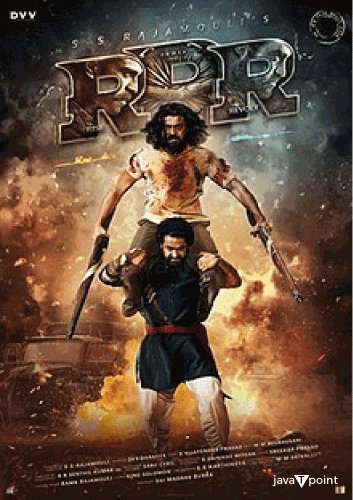RRR ReviewsThe Telugu-language Indian action epic "RRR" (short for "Rise Roar Revolt") made a special one-night-only debut in US theatres on June 1 following its first theatrical release. With some hindsight, it's easy to hypothesise as to why writer/director S.S. Rajamouli, despite his constant box office success, has just recently made a name for himself with "RRR" among Western audiences. Rajamouli's latest film is a buddy drama and anti-colonial tale about the fictional friendship of two real-life liberation fighters, Komaram Bheem (NT Rama Rao Jr.) and Alluri Sitarama Raju (Ram Charan). Furthermore, "RRR" is an excellent showcase for Rajamouli's signature emphasis on lavish stuntwork, pyrotechnics, and computer graphics. By the time he made "RRR," Rajamouli had honed his unique brand of Nationalistic self-mythologizing with the help of dependable collaborators such as recurring story writer (and biological father) Vijayendra Prasad and both co-leads, who had previously appeared in Rajamouli's "Yamadonga" and "Magadheera," respectively. "RRR," which is set in and around Delhi in 1920, intentionally omits historical context in order for Rajamouli and his team to turn a conventional rescue attempt into a rallying cry for togetherness and cathartic violence. Bheem, the vengeful "shepherd" of the Adivasian Gond tribe, journeys to Delhi to find Malli (Twinkle Sharma), a vulnerable pre-teen who was kidnapped from her Gondian mother by the cartoonishly wicked British Governor Scott (Ray Stevenson) and his cruel wife Cathy (Alison Doody). 
Raju, a peerless Colonial cop, befriends Bheem despite their opposing goals: Raju wants to apprehend the unidentified "tribal" that Scott's lackey Edward (Edward Sonnenblick) is concerned may be lurking nearby, while Bheem wants to break into Scott's fortress-like quarters to rescue Maali. Rajamouli's love for Cecil B. DeMille-style melodrama is palpable from the time Raju and Bheem become friends after rescuing an unconnected youngster from a train. (Mel Gibson's action/period dramas, as well as those of fellow DeMille-ian Mel Gibson, are acknowledged inspirations on Rajamouli, as is "Ben Hur"). It's also fitting that Rajamouli's crowning work, "RRR," is about Bheem, who serves as an inspiring example of a quasi-traditional, boundary-crossing patriotism. Rajamouli has mastered the skill of incorporating potentially harsh elements into his energetic, imaginative, and visually striking battle sequences and dance routines, such as his cheap-seats love of brutal violence and loud sloganeering. Rajamouli has already mastered how he works with and employs his performers as part of his shock-and-awe melodrama. His messianic qualities are also successfully demonstrated in a few rousing set pieces, such as when a bare-chested Bheem wrestles a tiger into submission. Rama Rao is an ideal fit for the character of the sweet-natured Bheem. Rama Rao's performance isn't the main attraction. Nonetheless, it acts as the symbolic impetus for an army of Indian residents to attack Scott and his savage hambone wife in a later scene, accompanied by a "Passion of the Christ"-worthy scourging. Similarly to that, Charan's steely-eyed performance in "RRR" is constrained but powerful enough to pass for superhuman. In an amazing opening action scene, Raju enters a raging mob in order to subdue and capture one specific rebel. Rajamouli is an expert at capturing his best aspects. The movie's flashy "Naatu Naatu" musical performance has already become a viral hit thanks to Rao and Charan's bro-mantic chemistry and rhythmic athleticism. Still, that scene's contagious delight is supra-human by design. In Rajamouli's films, the individual's spirit matters more than any one specific person, and "RRR" is the ideal illustration of that idea. It's also a decent portrayal of Rajamouli's success, which Sagar Tetali of Film Companion South insists is "the triumph of directorial ambition over the actor-star-the triumph of a brand of storytelling over the South Indian star image." Rajamouli's preference for one country ruled by populist uber menschen is reiterated in "RRR." Bheem and Raju are both remarkable people because they are aspirational expressions of the will of the people at their core. Their lives, loved ones, and relationships are all secondary consequences, thus it's only natural that the cast's photos and performances be blown up to James Cameron-sized proportions. ConclusionRajamouli, like Cameron, is known for pushing the boundaries of commercialised pop cinema. This is how "RRR" manages to feel both intimate and epic. Film Comment's R. Emmet Sweeney is accurate in warning audiences about Rajamouli's "Pan-Indian address's" towering vein of "Hindu-centric" nationalism and characterizations. Sweeney is also correct in congratulating Rajamouli on his outstanding "technical innovation." A new Indian film, which is frequently not publicised to Western viewers beyond native language speakers and is thus mostly ignored by Western networks, is rarely given to American moviegoers as an opportunity or risk losing out.
Next TopicSinam Movie Review
|
 For Videos Join Our Youtube Channel: Join Now
For Videos Join Our Youtube Channel: Join Now
Feedback
- Send your Feedback to [email protected]
Help Others, Please Share









